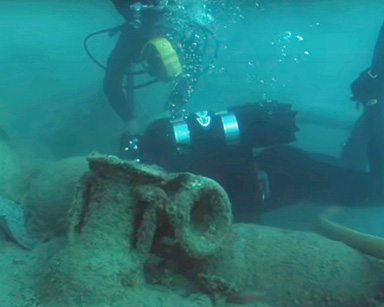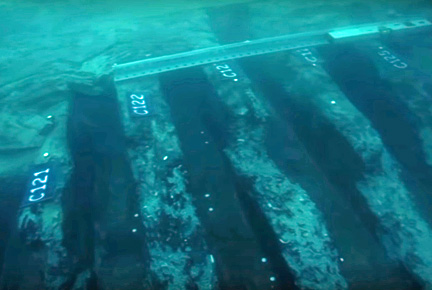|
Lead commonly costs about $1 per pound. Yet scientists from different disciplines are willing to pay more than 10 times that price for ancient lead, lead smelted by Romans two thousand years ago.
The contesting scientists come from seemingly unrelated fields: archaeology and particle physics.
 The ancient lead in dispute comes from ancient ships, mostly from the Roman Empire, lying on the bottom of the Mediterranean Sea. Some Roman ships contain 100,000 pounds of lead, primarily in the form of anchors and ballast. The ancient lead in dispute comes from ancient ships, mostly from the Roman Empire, lying on the bottom of the Mediterranean Sea. Some Roman ships contain 100,000 pounds of lead, primarily in the form of anchors and ballast.
For archeologists, ancient artifacts are priceless relics, each irreplaceable.
For particle physicists, ancient lead has immeasurable value for several types of groundbreaking experiments.
Both sides acknowledge the legitimacy of the other’s claims — yet both insist their needs are more important to the advancement of science.
 It’s clear why archeologists need ancient artifacts. It’s less clear why physicists do. In many experiments searching for extremely rare phenomena, no material beats ancient lead. It’s clear why archeologists need ancient artifacts. It’s less clear why physicists do. In many experiments searching for extremely rare phenomena, no material beats ancient lead.
From the earliest days of high-energy particle physics, scientists have used lead to absorb undesired particles. Some historians say Oreste Piccioni (that name sounds familiar) was the first to employ lead absorbers in a “modern” particle physics experiment. Any lead will do in most physics experiments, but not all.
Newly mined lead is slightly radioactive. Lead ore contains some uranium and other radioactive elements, and also the radioactive decay products of those elements, including Pb-210. While Pb-210 has a half-life of 22 years, it is continually being replenished by uranium and other decays. Smelting lead ore removes uranium and other radioactive elements, but does not remove Pb-210. The most abundant isotope of lead is Pb-208, which is not radioactive.
Neutrinos interact extremely weakly with normal matter. Trillions of neutrinos pass through our bodies each second, but in our entire lifetimes, only one or two will ever “hit” us (interact with our atoms). The rest simply pass through us without “touching” anything.
In neutrino experiments, physicists must meticulously monitor immense targets — some weighing thousands of tons — searching for faint signs of interactions that might occur once a day, once a month, or even less often. To have any hope of definitively detecting such rare events, extraordinary efforts are employed to eliminate all sources of more common interactions, such as those from cosmic rays and natural radioactivity. In these experiments, physicists need lead that isn’t radioactive.
Other types of experiments requiring non-radioactive lead include searches for neutrino-less double beta decay, proton decay, and dark matter detection — none of which have yet been observed, but all of which would herald new physics and open new windows to reveal nature’s secrets.
 Lead smelted by Romans thousands of years ago (~100 Pb-210 half-lives) can be 100,000 times less radioactive than new lead, and hence invaluable to both physicists and archaeologists. Lead smelted by Romans thousands of years ago (~100 Pb-210 half-lives) can be 100,000 times less radioactive than new lead, and hence invaluable to both physicists and archaeologists.
United Nations conventions (not quite laws) give archaeologists first rights to all sunken relics. While commercial sales are explicitly forbidden, relics may be used “for the benefit of mankind as a whole”. Relics aren’t completely sacrosanct; archaeologists routinely send them to science labs for radioisotope dating and DNA analysis, necessitating their destruction.
These days, more ancient shipwrecks have been discovered than archaeologists can afford to excavate, and more than they can afford to protect from looters. Much better funded physicists have paid for proper archaeological excavations in exchange for a modest percentage of the recovered ancient lead.
At least some archaeologists have decided they want their cake, even if it’s missing a slice.
Best Wishes,
Robert

May, 2020
Note: Previous newsletters can be found on my website.
|